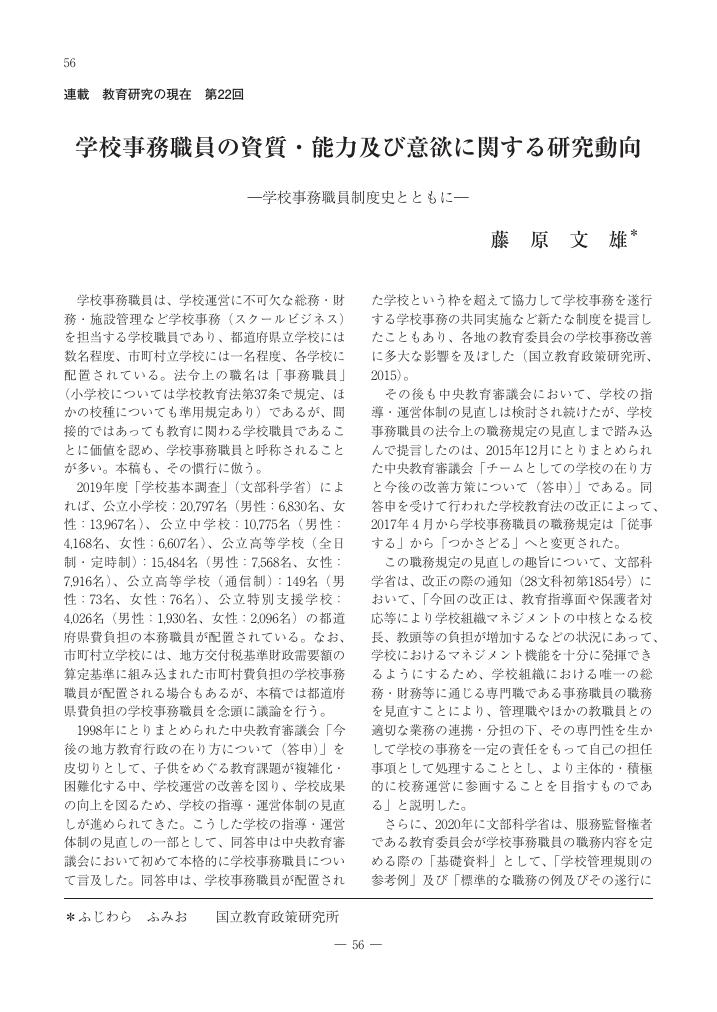- 著者
- 藤原 文雄
- 出版者
- 東京大学大学院教育学研究科教育行政学研究室
- 雑誌
- 東京大学大学院教育学研究科教育行政学研究室紀要 (ISSN:13421980)
- 巻号頁・発行日
- vol.17, pp.2-21, 1998-03-28
The importance of collaboration has been emphasized in the discourse of educational reform, yet it mayeeasier to talk about the notion as a nomalised idea than to achieve it in practice. Besides, the term of collaboration it self has remained consepually amorphous and sanguine. So, this paper tries to elaborate the term of collaboration by the works of investigation of political and theoretical background which has spawned the present enthusiasm for teacher collaboration. By such works, we report that collaboration should be interpreted as interaction to establish shared knowledge and meanings between teachers and dynamic process in which knowledge is constituted which has possibility of managing of a weak point of "educational organization as loosely coupled system". At the same time, however, we report that all teachers must adapt their notions of roles and responsibility an s a set of communication skills to achieve collaboration in above sense. We explore the central notion" reciprocity" "redundancy" in the process of collaboration. Finally, we point out that succesfull collaboration depends on the withdom of the headteachers in the therms of maintaining teachers' autonomy which is the essence of" educational system of loosely coupled system".
1 0 0 0 OA 学校事務職員の資質・能力及び意欲に関する研究動向 学校事務職員制度史とともに
- 著者
- 藤原 文雄
- 出版者
- 一般社団法人 日本教育学会
- 雑誌
- 教育学研究 (ISSN:03873161)
- 巻号頁・発行日
- vol.88, no.1, pp.56-64, 2021 (Released:2021-10-19)
- 参考文献数
- 40
- 著者
- 藤原 文雄
- 出版者
- 東京大学大学院教育学研究科教育行政学研究室
- 雑誌
- 東京大学大学院教育学研究科教育行政学研究室紀要 (ISSN:13421980)
- 巻号頁・発行日
- vol.18, pp.125-135, 1999-03-27
- 著者
- 藤原 文雄
- 出版者
- 日本教育経営学会
- 雑誌
- 日本教育経営学会紀要 (ISSN:02872870)
- 巻号頁・発行日
- vol.56, pp.24-34, 2014-05-30 (Released:2017-07-06)
The purpose of this study is to consider new perspectives on education management corresponding to a school's diversification of staff. The following three issues are discussed here: 1) Reasons for increased scholarly interest in such diversification based on the point of view of school workforces and research results from the 1960s through 1970s, 2) Reasons for renewed scholarly interest based on the point of view of school workforces and research results after the 1990s, and 3) School staff diversification in foreign countries and England's Workforce Reform. 1) In the first section, we clarified that the rise in the number of full-time support staff and support staff-teaching staff ratios led to increased interest in diversification based on the point of view of school workforces. Additionally, the most important research results of the period from the 1960s through 1970s were that support staff could improve the quality of education by cooperating with teaching staff. 2) In the next section, we clarified that the diversification of the school workforce advanced after the 1990s. Diversity management emerged as a solution to the problems caused by this increase in diversity. 3) In the final section, we discuss the advancement of school workforce diversification in foreign countries after the 1990s and England's Workforce Reform, which worked toward both staff diversification and improvement of their efficiency.
